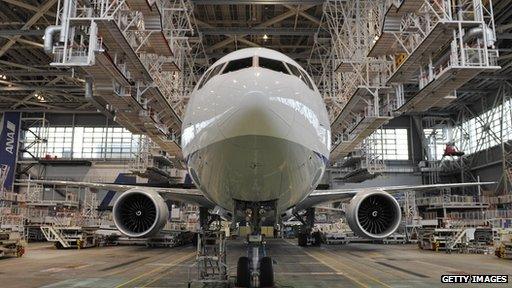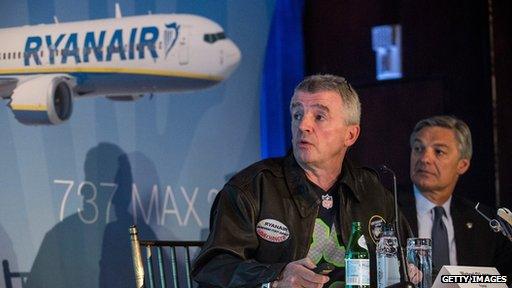Airlines told to change cockpit screens in Boeing planes
- Published

Airlines face having to replace the display screens in affected aircraft
Airlines have been ordered to replace or modify the cockpit display units fitted to hundreds of Boeing jets.
The US air safety regulator said, external that tests had indicated that mobile phone and computer signals could cause the screens to go blank.
The affected planes are typically fitted with several screens, each of which costs thousands of pounds.
Honeywell - the displays' manufacturer - has stressed that the problem has not been experienced in-flight.
"The only known occurrence was during a developmental test conducted on the ground," said spokesman Steve Brecken.
"We worked with Boeing and addressed any concerns in 2012 with new display hardware."
Boeing had previously issued an alert in November 2012 after an aeroplane operator and wi-fi vendor noticed interference caused by the installation of an in-flight internet system.
The "phase 3" display units were found to be susceptible to the same radio frequencies used to transmit data via wi-fi.
In addition, the Federal Aviation Administration (FAA) said it was concerned that the screens could be disrupted by mobile satellite communications, cellular signals from phones, and air surveillance and weather radar.
The watchdog noted that the displays were required to provide pilots with information about airspeed, altitude, heading and pitch and roll, and added that the fault could cause a crash.

The FAA has said that it believes more than 1,300 planes will need to be modified
"We are issuing this AD [airworthiness directive] to prevent loss of flight-critical information displayed to the flight crew during a critical phase of flight, such as an approach or take-off, which could result in loss of airplane control at an altitude insufficient for recovery, or controlled flight into terrain," it said.
Airline resistance
Planemaker Boeing said that it had recommended that carriers implement the changes back in 2012.
However, the FAA said that it had estimated that a total of 1,326 Boeing 737 and 777 jets still needed to make the change.
It estimated that the replacement programme would cost about $13.8m (£8.5m) to implement.
The agency noted that Virgin Australia, Air France, Ryanair and Honeywell were among those that had opposed the new rules on the grounds that they did not believe either current in-flight wi-fi systems or passengers' electronic devices emitted signals at a strong enough level to affect equipment on the flight deck.
The FAA said Ryanair had complained that the demands imposed "a high, and unnecessary, financial burden on operators".

Ryanair told the FAA that forcing all airlines to change the screens was "unnecessary"
Honeywell had suggested that airlines should be forced to install new screens only if wi-fi enabled tablets or other such equipment were used in the cockpit.
However, the FAA rejected these complaints saying it wanted to "eliminate" any risk of interference.
"We do not agree that no problems have occurred on in-service airplanes, since the wi-fi... testing that disclosed this susceptibility was conducted on an in-service airplane fitted with phase 3 display units," it added.
The Federal Aviation Administration has given the firms involved five years to swap or modify the components.
Experts said the public should not be alarmed.
"Passengers should not be worried at all," said Laurie Price, an independent aviation industry analyst.
"The fact the FAA has given airlines five years to do this suggests that the problem is of some concern, but it is not of significant concern."
Stephen Trimble from Flight International magazine added: "There's a lot of redundancies built into the planes' systems.
"It's extremely unlikely for this thing to happen. Southwest Airlines gave some data showing they have been running Boeing 737s with these display units for about 2,300,000 hours since installing a wi-fi system with no issues at all."
A spokesman for Ryanair told the BBC: "Ryanair will, as always, comply fully with this FAA directive, in conjunction with the IAA [Irish Aviation Authority], before its due date - 2019."
- Published26 September 2014

- Published5 June 2014

- Published21 December 2012

- Published14 May 2012
